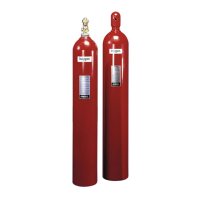Electronic data processing involves storage, recall and use
of information via electronic equipment. Electronic data pro-
cessing equipment is found in almost every industry today.
The equipment is very sensitive and operates within minute
tolerances. Additionally, many computer installations are
designed with a subfloor area containing data and power
cable bundles.
Because of the high dollar valve of the equipment, the data
managed by that equipment and the productivity provided
by electronic data processing, rapid detection and efficient
fire protection are imperative. Time lost to cleanup and ven-
tilation of a computer room means lost time throughout the
company, so these areas require a clean, no residue gas
agent that disperses easily.
The computer room and subfloor space can be protected
with an INERGEN suppression system, even when the
computer room is normally occupied.
Fires can occur within the computer electrical insulation and
in the cable bundles in the subfloor. Paper debris that has
been allowed to accumulate in the subfloor is also a source
for ignition.
Computer room/subfloor protection can be accomplished by
installation of a total flood INERGEN system. The
INERGEN system is designed in accordance with the Ansul
design, installation manual and NFPA Standard 2001,
“Standard for Clean Agent Fire Extinguishing Systems,”
which states, “the design concentration must be achieved
within 1 minute. It is important that an effective agent con-
centration not only be achieved, but shall be maintained for
a sufficient period of time to allow effective emergency
action by trained personnel.”
The INERGEN system consists of a cylinder bank, a piping
arrangement and discharge nozzles located in the room
and subfloor space.
Occasionally, drainage is installed in the subfloor area.
Provisions must be made for making the drain piping a
closed system unless water is present to assist in assuring
the necessary concentration.
When the computer room is normally occupied, personnel
safety is of first concern. Alarms or warning devices must
be located in the room to provide sufficient annunciation of
INERGEN agent discharge.The room and subfloor must be
tight to prevent loss of INERGEN agent.
All air handling equipment must be shut down and
dampered prior to system discharge.
Smoke detectors, operated by an electronic control panel,
are usually employed with an INERGEN system to provide
detection and thus suppression of a fire before it has a
chance to do serious damage.
Thermal detectors are used as a backup automatic system.
The authority having jurisdiction may have additional
requirements.
HAZARD
A computer room having dimensions of 20 ft. x 13 ft. x 10 ft.
A subfloor having dimensions of 20 ft. x 13 ft. x 1 ft.
No unclosable openings.
Ventilation to be shut down at system actuation.
No. 1 – Sketch of Hazard. Do an accurate sketch of the
hazard area and record all dimensions and solid objects.
No. 2 – Preliminary Drawing – Complete a draft sketch of
the piping layout to determine pipe lengths and number of
fittings. Locate and number all node points, manifold desig-
nators, and nozzles.
No. 3 – Pipe Input Section – Complete the Pipe Input
Section (tab) of the INERGEN Designer Program. Once
completed, print out the pipe input results.
No. 4 – INERGEN Flow Calculation – Perform the
INERGEN Flow Calculation and print out the Flow Report
and the Nozzle Performance Report from the INERGEN
Designer Program.
No. 5 – Review Design Concentration and Discharge Time
– Return to the Design Section (tab) of the INERGEN
Designer Program and review the design concentration and
discharge time for each hazard area to verify system perfor-
mance. Also, at this point, verify that the piping used in the
down stream piping is acceptable for the pressures identi-
fied as maximum down stream pressure on the
INERGEN Designer Flow Report.
SECTION XI
UL EX-4510 7-15-02 Page 11-1
REV. 1
ANSUL
®

